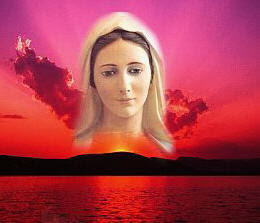
Feast Day of "Our Lady of the Pillar "
Saragossa, Spain 40A.D.
After the Crucifixion, Resurrection and Ascension of Jesus, His Apostles began to spread the message He left throughout Israel and shortly thereafter, through the Roman empire. One of these Apostles, James the Greater, reportedly traveled as far west as Spain to the village of Saragossa in northeast Spain. While James was there, circa 40 AD, he became disheartened because of the failure of his mission. Tradition holds that while he was deep in prayer, Jesus' Blessed Mother appeared to him and gave him a small wooden statue of herself and a column of jasper wood and instructed him to build a church in her honor, saying: "This place is to be my house, and this image and column shall be the title and altar of the temple that you shall build."
Another version holds that James, praying with his disciples along the banks of the Ebro River, suddenly heard angels singing "Ave Maria" and saw the Blessed Virgin appear standing on a pillar of marble. The Virgin, who still lived among men, asked James to build a chapel there, and promised "to remain at that site until the end of time, so that the grace of God will work omens and marvels through my intercession for those who, in their hour of need, invoked my name." Our Lady then disappeared, leaving behind the pillar. James and the eight other witnesses dedicated all their efforts to building the church Our Lady had requested. Before the church was finished, James needed to return to Judea. He then ordained one of his disciples to serve as priest, consecrated the chapel, and dedicated it to Santa MarÃa del Pilar, or Holy Mary of the Pillar. This was the first church dedicated to honor the Blessed Mother. After James returned to Jerusalem, he was executed by Herod Agrippa on about 44 AD, the first Apostle to be martyred for his faith. Several of his disciples took his body and returned it for final burial in Spain. The local queen, observing several of the miracles performed by James' disciples, converted to Christianity and permitted James' body to be buried in a local field.
Eight centuries later, a cathedral in honor of St. James was erected on the site of his gravesite, rediscovered by a local hermit. The hermit found the burial site after noticing an unusual star formation. The site for the cathedral was thus called Compostela (starry field), and it is a major pilgrimage site to this day.
Pope Clement XII fixed the feast day of Our Lady of the Pillar on October 12, a date that we know today as El DÃa de La Raza, as it commemorates Columbus' first sighting of American land. In 1984, Pope John Paul II recognized Our Lady of the Pillar as the patron saint of all Hispanic peoples.
Three Characteristics Unique to the Virgin of the Pillar
1- This is an apparition of the Virgin while still among men, before her Assumption into heaven.
2- Our Lady herself brings the column that will serve as her altar in the first Marian temple to be erected.
3- The connection between the Virgin of the Pillar and James the Greater gives rise to two important shrines, that of Our Lady in Saragossa, and that of James at Compostela, which constitute the two fundamental anchors of Spanish faith.
Sources:The Marian Library/International Marian Research InstituteMarian Titles in the Popular Religiosity of Latin America
MarÃa, Madre de las Américas
The Apparitions of the Virgin Mary

No comments:
Post a Comment
Please no anonymous comments. I require at least some way for people to address each other personally and courteously. Having some name or handle helps.
Note: Only a member of this blog may post a comment.